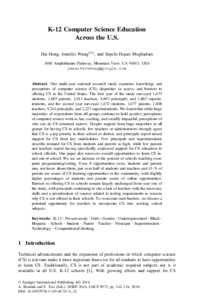K-12 Computer Science Education Across the U.S.Hai Hong, Jennifer Wang, Sepehr Hejazi Moghadam
Zu finden in: Informatics in Schools: Improvement of Informatics Knowledge and Perception (Seite 142 bis 154), 2016
  |
 |
 Zusammenfassungen
Zusammenfassungen
 Our multi-year national research study examines knowledge and perceptions of computer science (CS), disparities in access, and barriers to offering CS in the United States. The first year of the study surveyed 1,673 students, 1,685 parents, 1,013 teachers, 9,693 principals, and 1,865 superintendents, and the second year surveyed 1,672 students, 1,677 parents, 1,008 teachers, 9,244 principals, and 2,227 superintendents. We found that while large majorities of respondents from all groups continue to hold positive perceptions of computer science work as fun, exciting, and socially impactful, perceptions of who can do CS remained narrow. Despite support from large majorities in all groups for having CS in schools, few teachers or administrators strongly agree that CS is a top priority in their school or district, and principals report mixed support for CS from key stakeholders. Few principals and superintendents describe demand for CS from students and parents as high, while few parents and teachers report having specifically expressed support for CS education to school officials. Our paper also uncovers overall opportunities to learn CS in- and out-of-school. We see an increase in the percent of schools teaching computer programming/coding. Even if opportunities exist, students and parents may not know about them; just over half of students and teachers and 43 % of parents are aware of CS learning opportunities in the community, with slightly higher percentages of students and parents aware of online opportunities. Barriers to offering CS in schools remain largely unchanged from year one of the study, with principals continuing to cite a lack of teachers with the necessary skills and a prioritization of courses related to testing requirements as reasons why CS is not offered in their schools. To overcome such barriers, we discuss a potential opportunity for teachers to incorporate CS into existing school subjects.
Our multi-year national research study examines knowledge and perceptions of computer science (CS), disparities in access, and barriers to offering CS in the United States. The first year of the study surveyed 1,673 students, 1,685 parents, 1,013 teachers, 9,693 principals, and 1,865 superintendents, and the second year surveyed 1,672 students, 1,677 parents, 1,008 teachers, 9,244 principals, and 2,227 superintendents. We found that while large majorities of respondents from all groups continue to hold positive perceptions of computer science work as fun, exciting, and socially impactful, perceptions of who can do CS remained narrow. Despite support from large majorities in all groups for having CS in schools, few teachers or administrators strongly agree that CS is a top priority in their school or district, and principals report mixed support for CS from key stakeholders. Few principals and superintendents describe demand for CS from students and parents as high, while few parents and teachers report having specifically expressed support for CS education to school officials. Our paper also uncovers overall opportunities to learn CS in- and out-of-school. We see an increase in the percent of schools teaching computer programming/coding. Even if opportunities exist, students and parents may not know about them; just over half of students and teachers and 43 % of parents are aware of CS learning opportunities in the community, with slightly higher percentages of students and parents aware of online opportunities. Barriers to offering CS in schools remain largely unchanged from year one of the study, with principals continuing to cite a lack of teachers with the necessary skills and a prioritization of courses related to testing requirements as reasons why CS is not offered in their schools. To overcome such barriers, we discuss a potential opportunity for teachers to incorporate CS into existing school subjects. Dieses Kapitel erwähnt ...
Dieses Kapitel erwähnt ...
 Personen KB IB clear | Jane Margolis | ||||||||||||||||||
 Begriffe KB IB clear | Informatikcomputer science , Informatik-Didaktikdidactics of computer science , Informatik-Unterricht (Fachinformatik)Computer Science Education , Informatikunterricht in der Schule | ||||||||||||||||||
 Bücher |
|
 Tagcloud
Tagcloud
 Zitationsgraph
Zitationsgraph
 Zitationsgraph (Beta-Test mit vis.js)
Zitationsgraph (Beta-Test mit vis.js)
 2 Erwähnungen
2 Erwähnungen 
- ICER 2018 - Proceedings of the 2018 ACM Conference on International Computing Education Research, ICER 2018, Espoo, Finland, August 13-15, 2018 (Lauri Malmi, Ari Korhonen, Robert McCartney, Andrew Petersen) (2018)
- Programming Misconceptions for School Students (Alaaeddin Swidan, Felienne Hermans, Marileen Smit) (2018)


- Programming Misconceptions for School Students (Alaaeddin Swidan, Felienne Hermans, Marileen Smit) (2018)
- How Machine Learning impacts the Undergraduate Computing Curriculum (R. Benjamin Shapiro, Rebecca Fiebrink, Peter Norvig) (2018)


 Anderswo finden
Anderswo finden
 Volltext dieses Dokuments
Volltext dieses Dokuments
 |  K-12 Computer Science Education Across the U.S.: Artikel als Volltext bei Springerlink ( K-12 Computer Science Education Across the U.S.: Artikel als Volltext bei Springerlink ( : :  , 126 kByte; , 126 kByte;  : :  ) ) |
 Anderswo suchen
Anderswo suchen 
 Beat und dieses Kapitel
Beat und dieses Kapitel
Beat hat Dieses Kapitel während seiner Zeit am Institut für Medien und Schule (IMS) ins Biblionetz aufgenommen. Beat besitzt kein physisches, aber ein digitales Exemplar. Eine digitale Version ist auf dem Internet verfügbar (s.o.). Aufgrund der wenigen Einträge im Biblionetz scheint er es nicht wirklich gelesen zu haben. Es gibt bisher auch nur wenige Objekte im Biblionetz, die dieses Werk zitieren.









 Biblionetz-History
Biblionetz-History